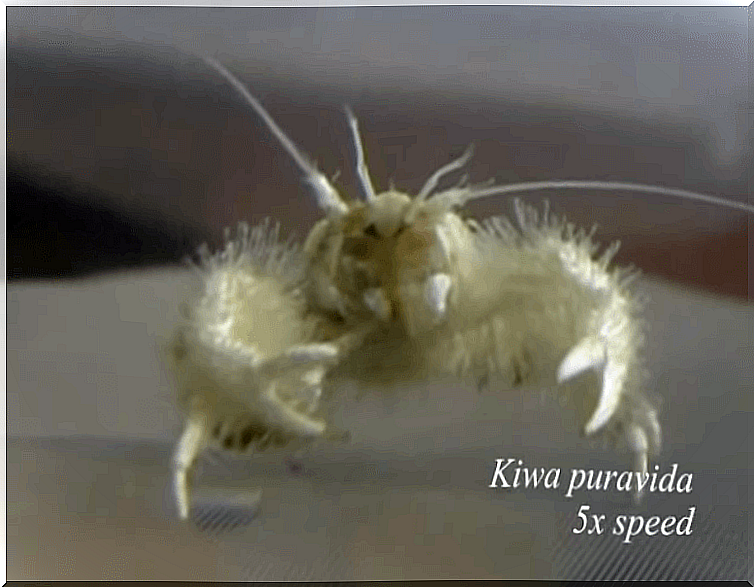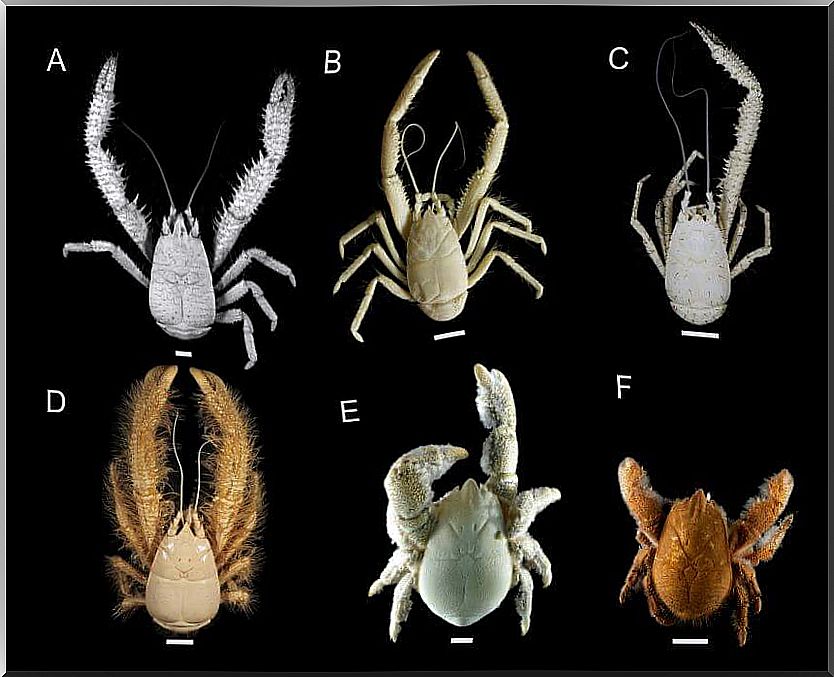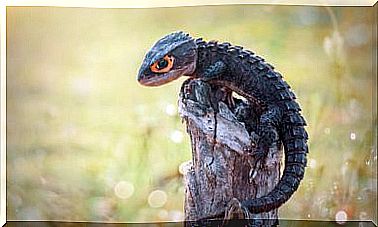The Yeti Crab And Attachment To The Warmth Of Life

Until recently, the Yeti crab ( Kiwa hirsuta ) was the only known species in a family of blind crustaceans, the so-called Kiwaidae (Decapoda: Galatheoidea).
This species is commonly known as “yeti” because, like the mythical character, its legs and cephalothorax are covered in white “hairs”. In this sense, it is interesting to clarify that these hairs, in reality, are flexible spines, which are called: “mushrooms”.
Yeti crab has to live in a tough neighborhood
The yeti crab was discovered in a deep-sea hydrothermal spring. Therefore, it is considered that he lives there.
At this point, it is appropriate to note that a hydrothermal source, vent or vent is a crack on the planet’s surface from which hot water flows. It is easy to imagine that such sources are in active volcanic areas.
Life in this oceanic niche presents several difficulties.
- First of all: extreme temperature changes. This is because although the volcanic water that gushes out can be at a temperature of up to 400 degrees Celsius, just a few meters from the source, the water is almost zero degrees Celsius.
- Additionally, the lack of sunlight is compounded by the low amount of oxygen. This is because hydrothermal vents release toxic sulfurous hydrocarbons that poison most animals and reduce dissolved oxygen.
So it is very difficult to breathe, and even more difficult to find food. Therefore, the animals that live there were forced to find different survival formulas.
Chemosynthesis as the basis of a food chain in extreme environments

Given that, at that marine depth, sunlight is non-existent, many organisms (such as archaea and Extremophiles) convert heat, methane and sulfur compounds that emanate from the thermal source into energy. They do this in a process called chemosynthesis.
Thanks to this process, these extremophiles serve as food for other complex life forms, such as giant tube worms, clams and shrimp. Thus, these organisms form the base of the food chain. Therefore, although life is scarce at these depths, hydrothermal vents are the backbone of these ecosystems.
How does the yeti crab fit into this niche?
Yeti crabs are now known to exist in these habitats because they can feed on bacteria that get energy from sulfur and methane that gush from hot springs. Amazingly, these crabs learned to grow their own food.
They do this by promoting the growth of bacteria in dense mats of your body “hair” on your arms and bellies. To feed their bacteria, yeti crabs huddle around areas where fluid from the seabed is released. There, they position themselves by waving their arms back and forth to gain as much access to the sulfur as possible.
Additionally, these crabs have another very important adaptation: greatly enlarged gill chambers that improve respiration. The large size of the gill chambers of yeti crabs undoubtedly allows them to tolerate low oxygen conditions.
The challenge of breeding under extreme conditions
In this marine niche, yeti crabs are confined to a very small habitable area. This is because if they get too close to the hot spring, they will be boiled alive, but if they get too far they could get hypothermia. Thus, the option is to stack, filling every available space.
However, their way of life poses some logistical problems.
For example, the habitable zone around thermal vents is too warm for yeti crab larvae, which need cooler temperatures to thrive.
This forces the females to leave the safe haven of their home and go out into the colder water to breed. The cold wreaks havoc on their bodies, which is why they only reproduce once before death.
How many species of yeti crab are known?
So far, six species have been found in total. The new yeti crabs, which have yet to be named and are somewhat different from their cousins. They do not have the same long claws as K. hirsuta and K. puravida . Also, their short claws are hairless, so they don’t accumulate bacteria there.
Instead, these yeti crabs have furry chests. The hairs on their chests are usually covered in bacteria, which are swept from the vent or “grown” on the hairs to eat later.

So far these are the species:
- Kiwa puravida
- Kiwa araonae
- Kiwa hirsuta
- Kiwa tyleri
- Kiwa sp . SWIR (no name)
- Kiwa sp . Galapagos Microplate (unnamed)
All of the yeti crabs discovered so far have been found in the southern hemisphere. Most of them, in the oceans that border Antarctica. That suggests that they originally evolved there.
Finally, yeti crabs have likely been around for quite some time. An analysis of their genes suggests that this family evolved around 100 million years ago.
Cover image: americanscientist.org









